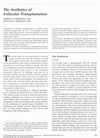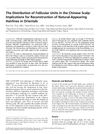TLDR Megasessions in hair transplant can cover more area or increase density but need a skilled team and careful planning, and have both benefits like less downtime and risks like lower graft survival.
The document from August 1, 2013, by Dr. Steven Gabel, discusses megasessions in hair restoration surgery, which are defined as transplanting more than 3000 grafts in a single session. These sessions can cover large areas of the scalp or achieve higher density but require careful patient selection, detailed planning, and an experienced team. Techniques to improve efficiency and maximize graft survival, such as organizing grafts, shaving the recipient area, and using methylene blue for site staining, are highlighted. The document notes the advantages of megasessions, like decreased downtime and less scarring, but also the disadvantages, such as higher risks and potential for decreased graft survival due to longer procedure times. It emphasizes the importance of minimizing graft out-of-body time, referencing a study by Limmer that showed a significant drop in survival rate from 95% at 2 hours to 54% at 48 hours. The document does not provide specific study numbers or outcomes but focuses on procedural aspects and considerations in hair transplantation megasessions.
1 citations
,
January 2008 in “Hair transplant forum international” Hair restoration surgery can lead to serious complications like blood clots.
 67 citations
,
September 1997 in “Dermatologic Surgery”
67 citations
,
September 1997 in “Dermatologic Surgery” The document concludes that good cosmetic outcomes in hair transplantation depend on the surgeon's artistic skill and careful planning.
172 citations
,
December 1994 in “The Journal of Dermatologic Surgery and Oncology” This hair transplant method improves cosmetic results for hair loss.
 October 2023 in “Facial Plastic Surgery”
October 2023 in “Facial Plastic Surgery” Beard hair is the best for body hair transplants, but the procedure is complex and requires experienced professionals.
 October 2021 in “Indian Journal of Plastic Surgery”
October 2021 in “Indian Journal of Plastic Surgery” You can use hair from other parts of the body for scalp hair restoration.
2 citations
,
September 2017 Hair and scalp diseases can affect hair transplant success in Asians, and managing them is crucial.
1 citations
,
November 2005 in “Hair transplant forum international” Understanding scalp conditions is crucial for successful hair transplants.
30 citations
,
August 2004 in “British Journal of Plastic Surgery” Chest hair can be successfully used for scalp hair transplants, growing longer like scalp hair.
 17 citations
,
June 2002 in “Dermatologic Surgery”
17 citations
,
June 2002 in “Dermatologic Surgery” Chinese patients have fewer hair follicles than Caucasians, and transplanting hair at 40% of normal density works for natural-looking hairlines.
 October 1987 in “Clinics in Dermatology”
October 1987 in “Clinics in Dermatology” Scalp reduction can improve hair distribution in certain baldness cases but requires careful patient selection and understanding of facial structure.
8 citations
,
February 1982 in “Plastic & Reconstructive Surgery” Scalp reduction can effectively treat male pattern baldness, especially when combined with hair transplants.





